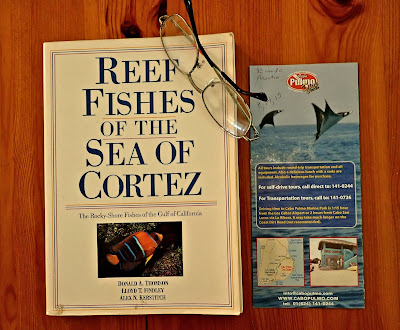Within hours of posting my story of the curious ray sighting in the Inner Harbour, I received an email from Bob Hillis. My old compañero, now residing in the Rockies, has re-invented himself as a marine biology research assistant with a focus on the Sea of Cortez. Considering that he lives in
 |
| A school of Bent Fin Devil Rays Elasmodiver.com |
southern Utah, this is quite a feat. At any rate, with this new marine focus, certain species are closer to the tip of his cerebral cortex than may be true for those of us who are somewhat limited to the biology of the Hawaiian Islands.
In this instance Bob thought of an animal which I have seen only once, at an extreme distance...the Bent Fin Devil Ray. Also known as Smooth Tail Mobula or Thurston's Devil Ray, this ray occurs near shore in tropical seas around the world. Curiously, it is less common in Hawaiian waters than many other places. It is far more common, for example, in the Sea of Cortez. My one sighting was at Cabo Pulmo, 40 miles north and a world away from San Jose del Cabo. From a deserted beach on the south side of the cape, Sandra and I watched these rays leap from the ocean. Although we were a hundred yards away, the image of a large ray leaping clear of the water remains indelible.
This was back in 2005, before I had friends like Bob Hillis and Peter Krottje to prod me towards better scholarship. I composed my fishlist for the trip to Cabo Pulmo from a field guide by Thomson,
 |
| Thomson et al and the Cabo Pulmo Brochere With Flying Mobulas |
Findley and Kersitch. It was written in 1979 and reprinted in 1987. Being ichthyologists, they have the fish in the correct order. This does not explain why they made a separate chapter for rays and sharks, which we all agree are fish, towards the end of the book. (Any ichthyologist knows that the cartilaginous fishes, being more primitive, belong at the beginning of the list.) Can you feel an excuse coming on? Being a bad ichthyologist myself, I put the sharks and rays at the end of my list and left out the Smooth Tail Mobula. Along with a picture of this old field guide I have included a brochure givento me at the Cabo Pulmo Dive shop featuring a picture of the not-so-notorious STM. Nevertheless, when Sandra and I saw these leaping rays they were duly recorded.
As a total aside, this was an incredible vacation. The small resort was in the middle of nowhere, right on the beach. Sandra and I had a tiny casita with a propane refrigerator and stove. Every day a different pickup would come down from LaPaz selling something..bread one day, fish the next. I'd love to go back.
 |
| Manta Ray, Kawaihae September 2020 |
Mobula thurstoni is one third the size of coastal manta rays and the pups are smaller, too. Bob worked as a dive guide here in Hawaii and thought that these rays, though rare, would be possible here and might be what we saw. With this in mind he recommended that I consult Deron Verbeck, who is perhaps the premier blue water guide here in Kona. Fortunately I met Deron two years ago when he showed us the tiger sharks near the airport. Here is what Deron said:
Yesterday we drove up to Kawaihae where we met up with Peter and Marla. They have completedtheir two week quarantine and were eager to go swimming. As we arrived Lottie alerted us that the mantas rays were in. As we arrived at the top of the stairs, we could see a fin about twenty yards away. As it turned out, we all swam about fifty yards before encountering our first ray.



Love the video. The Manta Ray swims so gracefully.
ReplyDelete